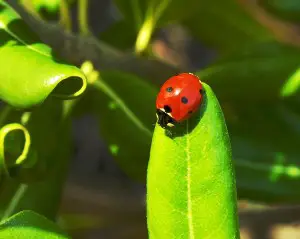Ladybugs are delightful-looking beetle-like creatures seen bopping amongst plants. Shaped as domed, half spheres, they are tiny and spotted with short legs and antennae. Ladybugs have been the subject of nursery rhymes and have been closely associated with agricultural farms. Most ladybugs voraciously consume plant-eating insects, such as aphids, and in doing so they help to protect crops. Ladybugs lay hundreds of eggs in the colonies of aphids and other plant-eating pests. When they hatch, the ladybug larvae immediately begin to feed. By the end of its three-to-six-week life, a ladybug may eat some 5,000 aphids.
Fact 1. Ladybugs secrete a fluid from the joints in their legs that gives them a foul taste. It protects and defends itself by playing dead while secreting the fluid to ward off its enemies.
Fact 2.  The name ‘ladybird’ originated in Britain where the insects became known as ‘Our Lady‘s bird’ or the ‘Lady beetle.’ Mary (Our Lady) was often depicted wearing a red cloak in early paintings, and the spots of the seven spotted ladybird (the most common in Europe) were said to symbolize her seven joys and seven sorrows.
Fact 3. Â Â In German, ladybugs are known as ‘œmarienhuhn’ (Mary’s chicken), ‘œmarien-kafer’ (Mary’s beetle), and ‘œmarienwurmschen’ (Mary’s little worm). ‘œMarienkuh’ was an earlier form related to the English “Lady-cow.” The Swedes used the name ‘œmarias nyckelpiga,’ and the farmers still call the insect ‘œthe Virgin Mary’s golden hen.’
Fact 4.  In these languages, the names link the insect with the protection of God. The French call it ‘œla bête a bon Dieu’ (God s animal), while the Spanish use the name ‘œvaquilla de Dios’ (God’s little cow).
Fact 5. Â Ladybugs are also known as ladyclock, ladycow, ladyfly, or lady beetle.
Fact 6. There have been Asian species of the ladybird released in North America to fight aphids.  The species of ladybird known as H. axyridis is used as a pest controller, and is the most common ladybird in North America. It is breeding rapidly in North America overtaking the native North American breed that is seriously declining. The seriousness of this is because the species is eating up the food of other ladybugs including eating the eggs.
Fact 7. Â Ladybirds swarmed farms, and children enjoyed warning the little bugs to flee from danger. ‘œLittle Ann’ was the farmer’s name for a young grub of the ladybird attached to a leaf and shedding its skin, or “weaving gold laces.’ This gave rise to the children’s song, ‘œLadybird, Ladybird, fly away home! Your house is on fire, Your children do roam. Except little Ann, who sits in a pan, weaving gold laces as fast as she can.’
Fact 8. Â In the 1890s when the California orange industry was experiencing a critical situation with trees being destroyed by aphids, ladybirds from Australia were introduced to stem the flight of the aphids. Economic entomology was an outgrowth of the ladybird experiment to salvage California’s orange-growing business.
Fact 9. Â The introduction of the Asian harlequin ladybird into Europe has seen a decline in the two-spotted ladybird in Britain.
Fact 10. Ladybugs help reduce pollution by allowing farmers and gardeners to use less pesticides and chemicals to protect their plants. It is estimated that insect predation provides $14.5 billion of natural pest removal.











Leave a Reply